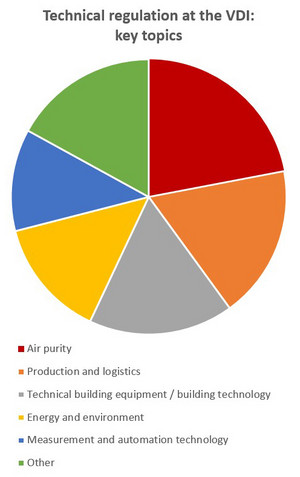KANBrief 3/17

Founded in 1856, the VDI (Association of German Engineers) currently has a membership of 155,000 individuals and has a long tradition in technical regulation. Every year, over 200 new or updated VDI standards are published. Together with other technical regulators, the VDI supports the objective of creating a coherent body of regulations covering all areas of technology.
In 1881, the VDI took the decision to promote the comparability of investment goods, and in the following year published the draft of a standard in its weekly periodical. The readers of the periodical were to be given the opportunity to comment upon this text. On 8 March 1884, the first VDI standard, setting out principles for the inspection of steam boilers and steam engines, was published in the VDI's periodical.
VDI standards
Some 2,000 VDI standards are now available. They are available for purchase from the Beuth publishing house and can also be inspected at designated libraries. The VDI maintains a close relationship with DIN, as can be seen from two joint standards committees: the VDI/VDE commission on air pollution prevention (KRdL) and the DIN/VDI Acoustics, Noise Control and Vibration Engineering Standards Committee (NALS). The decision to develop a VDI standard versus a DIN standard is frequently made according to the topic or for historical reasons. Discussion of topical subjects in VDI committees often reveals a need for the current state of knowledge to be set out in a standard. Where European or international standardization is an objective, VDI standards serve in some cases as a basis for ISO, IEC or EN standards.
Through its body of standards, the VDI aims to make descriptions of generally accepted good practice available that provide experts with assurance that by applying them, they are acting correctly. Familiar examples of VDI standards are:
Procedure for work on VDI standards
VDI standards are developed on the consensus principle, by a community of approximately 10,000 experts working on a voluntary basis in 600 VDI committees. The work is conducted in accordance with VDI 1000, VDI Standardisation Work – Principles and procedures, which describes the objective, procedures and statutory principles of work on VDI standards. A revised version of VDI 1000 was published in February 2017 with new and more detailed content:
Relationships to OSH issues
The VDI's activities are frequently related to OSH issues, above all in the VDI's Safety and Management technical division. Important aspects of industrial safety are addressed in this division, for example in VDI Standard 4068, Competent persons. Discrete topics such as additive manufacturing methods, securing of loads, elevator technology and drinking water hygiene also have a bearing upon occupational safety and health, however. Cooperation with OSH representatives in these areas already takes place, generally through the responsible accident insurance institutions. The intention is for this cooperation to be placed on a systematic footing in the future through the KAN Secretariat.
Dieter Westerkamp
westerkamp@vdi.de